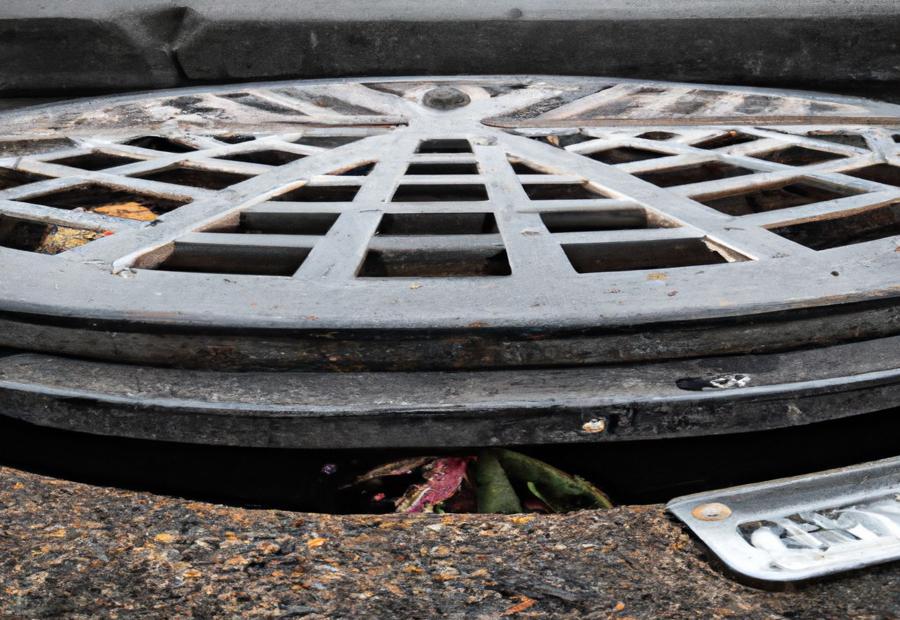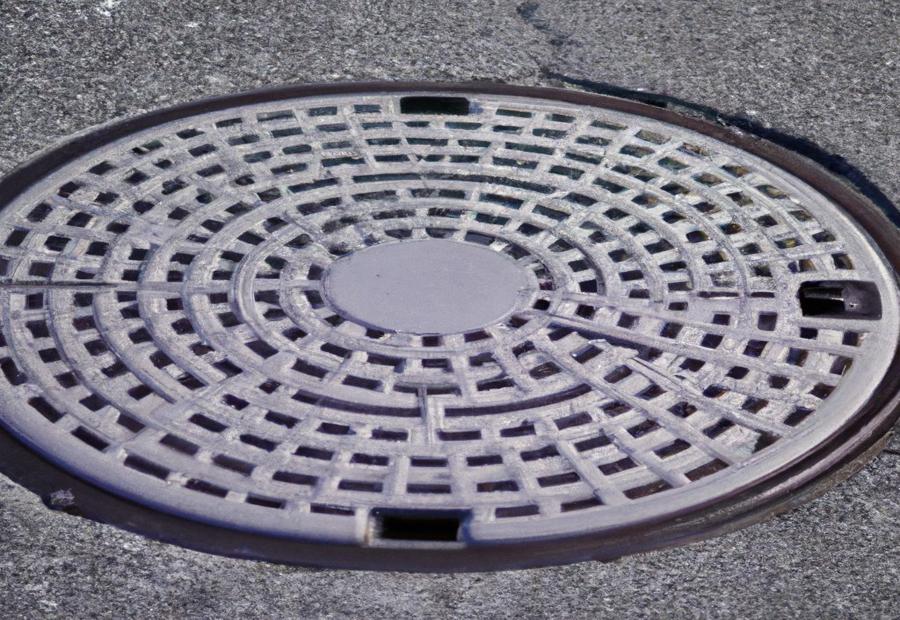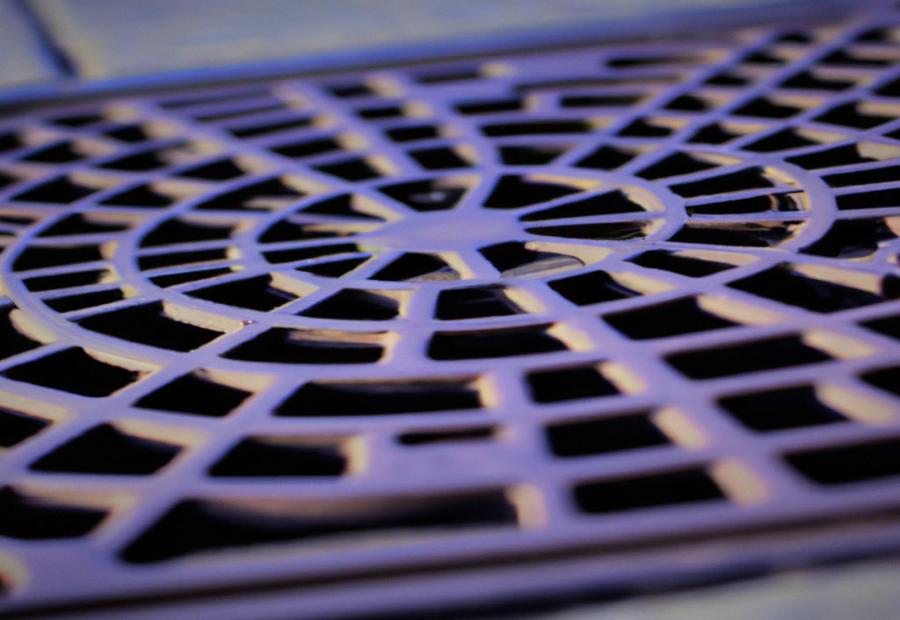.jpg)
.jpg)
.jpg)
Key Takeaways:
- Manholes play a crucial role in efficient maintenance and inspection of underground systems. They provide access points for workers to inspect and repair various services such as sewer lines, electrical cables, and telecommunications.
- Manholes serve as emergency access points, allowing first responders to quickly access underground systems during emergencies. They provide a safe entry and exit point for personnel and equipment.
- Manholes contribute to traffic management by providing access points for utility companies to install, repair, and maintain infrastructure underground, minimizing disruptions to traffic flow on roads and sidewalks.



Photo Credits: Build-Wire.Com by Benjamin Young
Manholes serve a crucial role in our infrastructure, facilitating access to underground utility systems. In this section, we’ll explore the definition of a manhole and the purpose and importance they hold. Through understanding these key aspects, we’ll gain insight into how manholes contribute to the functionality and safety of our cities.
Definition of a Manhole
Manholes are a vital component of infrastructure, used for many purposes in many industries. They are openings in the ground that provide access to underground utilities, such as sewer lines, storm drains, or electrical cables. Heavy lids cover them to keep people safe and stop unauthorized entry.
Manholes are designed to make maintenance and inspection of underground utilities efficient. They are the entry points where maintenance crews can do routine inspections, cleanings, repairs, or replacements. Going through manholes allows workers to spot issues quickly and keep the utilities running smoothly.
In emergencies, like pipe blockages, leaks, or equipment failures, manholes allow quick access for emergency personnel. They provide a direct pathway to the underground systems.
Manholes also aid traffic management. Placed along roads and highways, they give maintenance crews easy access without disrupting the flow of traffic. This helps reduce disruption caused by repairs or inspections that involve excavation or road closures.
On top of all that, manholes keep people safe. Heavy lids make sure the openings can only be accessed by authorized personnel. This stops accidents or injuries caused by falls into open holes.
For centuries, manholes have been essential for urban development and infrastructure planning. They have evolved in design and construction materials, so they are now very durable and secure. They are a fundamental part of modern urban infrastructure, providing access to the utilities we need for everyday life.
Manholes: The perfect escape route for those who want to get away from traffic jams, and explore the underground!
Purpose and Importance of Manholes
Manholes are essential for infrastructure management. They offer efficient maintenance, inspection, emergency access, and traffic organization. They enable personnel and machinery access to wastewater, stormwater, and telecommunication networks below the surface, so any issues can be seen and handled swiftly.
Types of manholes vary:
- Maintenance holes for inspections and repairs
- Junction chambers connecting different lines
- Access shafts for more extensive equipment access, in complex networks
Concrete is the usual construction material; it’s strong and long-lasting. Plastic and fiberglass are other options, both resistant to corrosion.
Manholes are a crucial part of keeping things running smoothly – they may not be exciting, but they are a hole lot of work!
Efficient Maintenance and Inspection
Efficient maintenance and inspection of manholes is key for proper functioning. They provide access to underground utilities, enabling maintenance and inspection needed to ensure performance. Regular checks help detect any issues quickly, reducing the risk of failures that can disrupt services or pose safety hazards.
Manholes feature components to facilitate efficient maintenance and inspection. Covers, steps, ladders, platforms, and access shafts enable workers safe entry. This helps with necessary repairs and checks.
Regular inspections also identify potential problems before they worsen. By assessing condition of manhole structures and surroundings, signs of damage can be seen early. This proactive approach prevents service disruption and ensures public safety.
Efficient maintenance and inspection also aid traffic management. Manholes are usually in busy areas. Quick repair keeps roads open and avoids inconveniencing the public.
To conclude, efficient maintenance and inspection is essential for manholes. Regular checks and timely repairs keep these access points safe and functional. Who needs superpowers when you have a manhole for emergency access?
Emergency Access
Emergency access for manholes requires 3 steps to ensure safety:
- Firstly, markers or signs should be placed near manholes to identify them quickly when needed.
- Secondly, secure entry points should be installed by using locking mechanisms or covers.
- Lastly, staff need training and drills for emergency procedures.
Following these steps will help boost public safety. Plus, safety guidelines must always be followed.
Traffic Management
Manholes have a vital part in traffic management. They allow efficient repairs and inspections of underground utilities, allowing for quick recognition and settling of any troubles. This makes sure that any required fixes or upgrades can be done with minimal disruption to road users. Manholes also provide emergency access to first responders, permitting them to quickly reach underground facilities in case of emergencies.
While construction projects or other circumstances that require temporary road blockages or detours, manholes make traffic management simpler by providing simple access to underground utilities. By introducing manholes into the overall traffic infrastructure, road closures can be overseen more effectively.
Manholes are constructed with diverse materials, such as concrete, plastic, or fiberglass. The choice of material depends on the exact demands and conditions of the site. For high-traffic areas, concrete manholes are chosen due to their strength and durability. Plastic manholes are suitable for places with high humidity as they are light and resistant to corrosion. Fiberglass manholes give a combination of power and corrosion resistance, making them adaptable options for different uses.
An example illuminates the effect of a thorough manhole maintenance program on traffic management. In a busy city center, frequent repairs to underground utility lines caused heavy traffic congestion and trouble for commuters. The local authorities opted to invest in regular inspection and upkeep of manholes to address these matters promptly. As a result, traffic congestion drastically minimized, and the daily journey became smoother for all inhabitants and visitors to the city. This success story highlights the critical part that manholes play in managing traffic correctly and ensuring public safety on our roads.
Types of Manholes



Photo Credits: Build-Wire.Com by Ronald Martinez
In the realm of manholes, there are various types that serve distinct purposes. In this section, we will explore the different types, from maintenance holes to junction chambers and access shafts. Each type plays a crucial role in the infrastructure, allowing for essential maintenance, efficient drainage systems, and easy access to underground networks. Join us as we delve into the world of manholes to understand their diverse functionalities and their significance in urban development.
Maintenance Holes
Maintenance holes have key components. Access covers provide secure entry and ladders, steps, and handrails help with descending. This makes maintenance easier and safer.
These openings are also important in emergencies. They provide quick access to utilities or confined spaces. This can be vital for rescue operations or when dealing with utility failures.
Maintenance holes also help public safety on roads. Traffic management features like cones and signs alert drivers to potential hazards. This helps prevent accidents and keep traffic flowing.
Overall, maintenance holes are key components of manholes. They help efficient upkeep, inspection, and public safety. They minimize disruptions caused by maintenance.
Junction Chambers
Junction chambers, also known as junction boxes, play a vital role in urban infrastructure. They are specially designed to connect multiple pipelines or cables. Placing them in manholes makes maintenance and inspection of underground utilities simpler.
There are various benefits of junction chambers. They help with efficient maintenance and inspection of underground utilities. As they are located at the intersection of multiple utility lines, repairs, inspections, and routine maintenance are made easier.
In emergency situations, junction chambers provide quick access to underground utilities. This is important for public safety and helps to avoid disruption.
They also help with traffic management. Junction chambers are strategically placed, allowing access to underground infrastructure without interrupting traffic. By connecting pipelines and cables, they keep underground utilities intact and traffic running smoothly.
The concept of junction chambers has been used for decades in urban planning. Improvements in construction materials and techniques have improved their design and functions. As a result, they have become a necessary part of modern manholes and help with the efficiency and reliability of underground utilities.
To sum up, junction chambers help with maintenance, inspection, and emergency management of underground utilities. They are essential for urban infrastructure development and have been used for many years. Improvements in construction materials and techniques have made them even more valuable.
Access Shafts
Access Shafts: essential components of manholes. They provide personnel with points of entry to maintain and inspect underground infrastructure. Emergency response is made simpler with their design. Traffic management is also aided, due to the shafts’ ability to monitor and manage utility networks.
Safety features like ladders and platforms can be added to ensure safety of personnel entering the manhole. The material used for construction varies, based on load-bearing capacity, environmental conditions, and more. Concrete is typically selected for its strength and resilience. Plastic or fiberglass can also be used, providing lighter options that resist corrosion and moisture.
In conclusion, Access Shafts offer easy access for maintenance and inspection. They also support emergency access and traffic management. The materials used for construction are chosen for their durability and resistance, and safety features are added for public safety.
Components of a Manhole



Photo Credits: Build-Wire.Com by Michael Hall
A manhole is an important piece of underground utility networks, allowing access for maintenance and inspection. It’s made up of various parts that help it perform and endure.
Cover and frame make the topmost part, providing a secure entry and protecting what’s inside.
Riser, or the shaft/barrel, connects the cover and frame to the base.
The base is at the bottom, evenly distributing the weight and staying stable.
Steps and ladders are for safe entry/exit and often built into the riser wall.
Jointing materials like gaskets/sealing compounds prevent water infiltration and keep the manhole solid.
Accessories like vent pipes, covers, lighting, and safety devices increase functionality and safety.
Manholes are designed and constructed to last, with each component contributing to its integrity and accessibility, keeping the underground utility network running.
Importance of Manholes for Public Safety



Photo Credits: Build-Wire.Com by Henry Miller
Manholes are essential for public safety. They provide access to underground systems and allow for efficient repairs. Plus, they stop unauthorized access and are built with durable materials like concrete or cast iron. This ensures their stability and longevity.
Manholes must adhere to regulations and standards. Different types are designed for different utilities. For example, electrical or communication manholes for maintenance and troubleshooting, and stormwater manholes to manage water flow during heavy rain.
To protect public safety, authorities and utility companies must inspect and maintain manholes. Neglecting them can lead to potential hazards. Therefore, it is important to prioritize their upkeep to ensure the safety of our communities.
Regular Maintenance and Inspection



Photo Credits: Build-Wire.Com by Thomas Garcia
Regular maintenance and inspection of manholes are essential. This helps identify potential issues and address them quickly, reducing the risk of accidents and disruptions to utility services. Here is a guide for proper maintenance and inspection:
- Visual Inspection: Check exterior and interior walls, cover, frame, and components for cracks, damage, or leaks.
- Remove Debris: Clear away any obstructions in the manhole.
- Check Structural Integrity: Examine walls, frame, and cover for signs of corrosion or deterioration.
- Test Ventilation System: Make sure vents are free of debris and airflow is unobstructed.
- Inspect Components: Check ladders, steps, rungs, and handholds for damage or wear.
- Clean Regularly: Remove sediment, grease, or other materials from the interior.
Keep records of maintenance and inspection activities, including dates, findings, and repairs. This info is invaluable for future reference and planning, ensuring manholes function properly.
By following these practices, manholes will stay in good condition, avoiding risks and keeping utility systems running smoothly.
Construction Materials and Techniques



Photo Credits: Build-Wire.Com by Christopher Allen
Construction Materials and Techniques play a crucial role in the durability and functionality of manholes. In this section, we will explore the diverse options available, including concrete, plastic, and fiberglass manholes. Discover how each material contributes to the physical properties and construction techniques, ensuring safe and efficient utility access.
Concrete Manholes
Concrete manholes are essential for urban infrastructure. They provide access to underground utilities and are designed for efficient maintenance, inspection, emergency access, and traffic management.
These manholes are used for routine inspections, cleaning, and repairs of underground systems. Junction chambers connect multiple utility lines. Access shafts enable personnel to enter for monitoring or repairs.
Concrete manholes have components that contribute to their function. This includes a cover or lid, riser walls, and steps/ladders. The reinforced concrete provides resistance against corrosion and can support heavy traffic loads.
Alternatives such as plastic and fiberglass are being used due to their lightweight properties. But, concrete manholes are still widely used due to their robustness and long-term performance.
Plastic Manholes
Plastic manholes, also known as polymer or synthetic resin manholes, are an alternative to traditional concrete ones. They are significantly lighter, making them easier to transport and install. Plus, they’re resistant to corrosion, chemicals, and extreme weather conditions.
In addition, their smooth interior surfaces prevent debris buildup and facilitate easy cleaning. Moreover, plastic manholes can be customized with various inlet/outlet configurations and extra features, like steps or ladders.
These features make plastic manholes a better choice in certain applications. They are the strong and lightweight superheroes of the underground world!
Fiberglass Manholes
Fiberglass manholes are a must-have for underground infrastructure. They’re utilized in the construction business for their toughness and immunity to corrosion. Fiberglass manholes present multiple advantages over traditional materials such as plastic and concrete.
- They’re lightweight which makes them simpler to move and install than concrete structures.
- Their smooth inside surfaces give great flow characteristics, lessening the likelihood of clogs or accumulation.
- Their chemical and weather immunity make them dependable and require minimal upkeep.
What’s more, fiberglass manholes can be custom-made to satisfy certain project demands. They can be designed with different inlet and outlet configurations, access points, and ladders for effortless entry and maintenance.
When it comes to resilience and performance, fiberglass manholes are superior in harsh settings. Their composition provides resistance to high temperatures, physical impacts, and caustic chemicals. With their lightweight nature and astounding strength-to-weight ratio, these manholes provide a cost-efficient solution without compromising structural integrity.
Conclusion



Photo Credits: Build-Wire.Com by Scott Thompson
Manholes are essential! They provide access to sewers, electrical lines, and telecommunication networks. Circular and rectangular ones are used depending on the requirements. They are usually made of concrete or metal, strong enough to handle the weight and pressure from above.
Constructing manholes involves careful planning and following safety regulations. This ensures the infrastructure is long-lasting and reliable.
Some Facts About “What is a Manhole – Purpose, Types, and Construction”:
- ✅ Manholes are covered openings in the ground that provide access to underground utility networks. (Source: Team Research)
- ✅ Manholes serve the purpose of efficient maintenance and inspection of underground systems. (Source: Team Research)
- ✅ Manholes have different types such as maintenance holes, junction chambers, and access shafts. (Source: Team Research)
- ✅ Manholes are important for public safety as they prevent accidents and protect people from falling into open shafts. (Source: Team Research)
- ✅ Manholes play a crucial role in preventing flooding by collecting and diverting excess rainwater. (Source: Team Research)
FAQs about What Is A Manhole – Purpose, Types, And Construction
What is a manhole and what is its purpose?
Answer: A manhole, also known as an inspection chamber, is an underground unit that provides access to underground utility systems such as sewer systems and drainage systems. Its purpose is to allow for maintenance, cleaning, and inspection of these subsurface utilities without the need for excavation.
What are the different types of manholes?
Answer: There are three main types of manholes based on their depth. Shallow manholes are located in low-traffic areas and serve for routine checks and repairs. Normal manholes are found near the sewer line and have a deeper depth. Deep manholes provide greater capacity and are used for accessing deep underground systems.
What materials are used to construct manholes?
Answer: Manholes can be constructed using various materials. Plastic manholes are made of polyethylene and are corrosion-resistant and environmentally friendly. Precast concrete manholes are assembled on-site and have a lifespan of up to a hundred years. Fiberglass manholes are lightweight and durable.
How do manholes contribute to public safety and infrastructure?
Answer: Manholes play a crucial role in protecting public safety by preventing accidents and ensuring people do not fall into open shafts. They also help in preventing flooding by collecting and diverting excess rainwater. Manholes are integral components of urban infrastructure and contribute to the functioning and longevity of modern societies.
What are the maintenance requirements for manholes?
Answer: Regular maintenance and inspection of manholes are important to identify issues and extend the lifespan of infrastructure. Damaged manhole covers should be repaired or replaced immediately to ensure safety. Cleaning manholes is essential to avoid blockages in water supply or sewer lines.
How do manholes facilitate utility maintenance and inspections?
Answer: Manholes serve as access points to underground utility systems, allowing for maintenance work, inspections, and obstruction removal from sewer lines. They are used for connecting sewer pipes at junctions, adjusting alignment or direction, and modifying gradients of sewer lines.